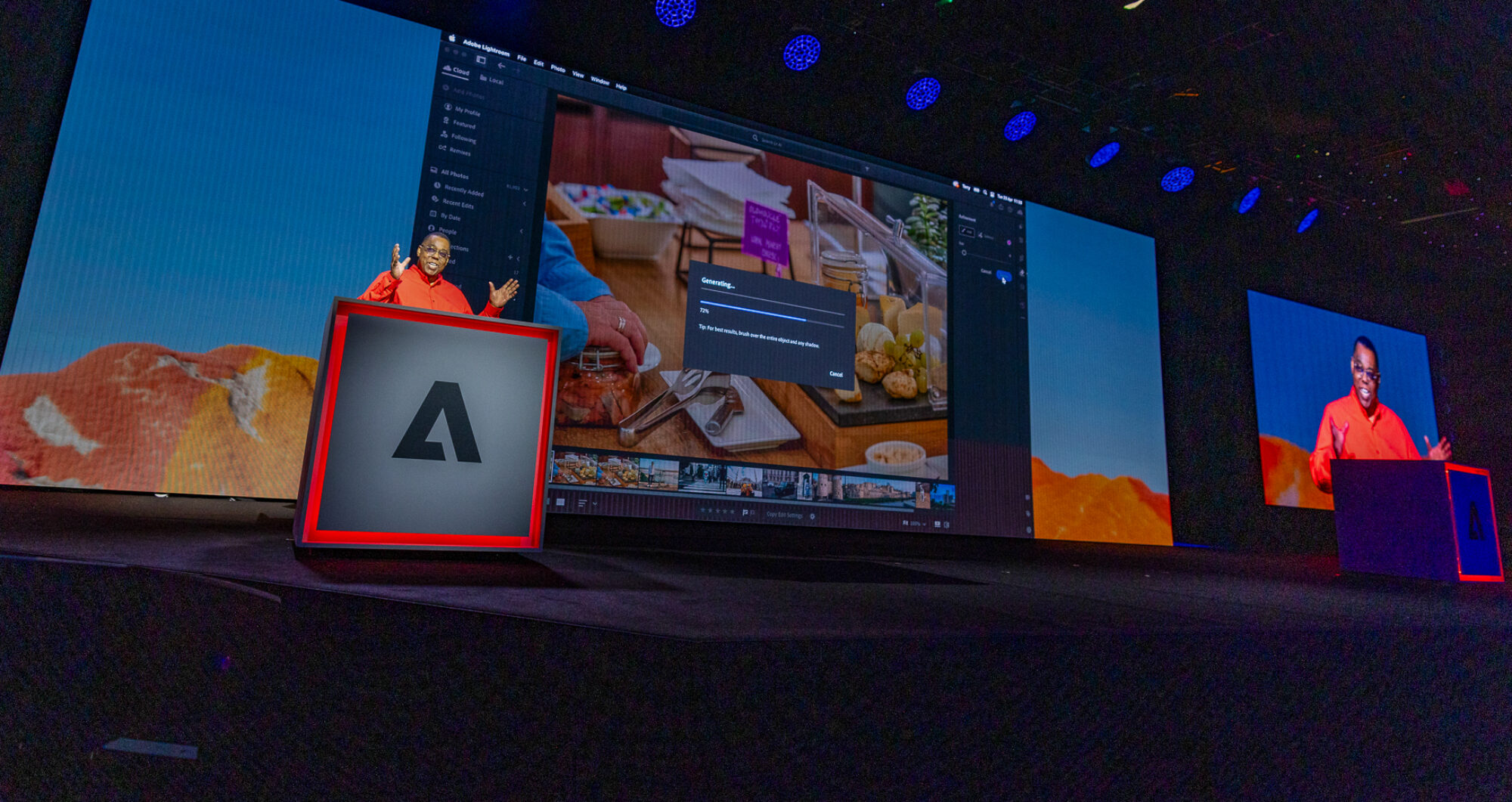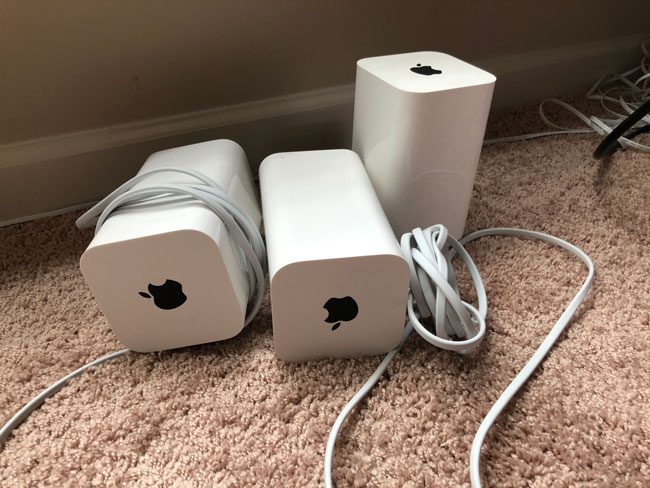
In case you missed it, Apple has officially announced the end of life of AirPort Base Stations. They will continue to sell existing stock, but the product will not get any new features and Apple will no longer develop this product line. What does that mean for existing users? If you have an existing AirPort WiFi network and it’s up and running with no issues, you’re probably fine for a while. I have three of the latest AirPort Extreme Base Stations and haven’t had any issues. They just work! However, I just replaced them. Why? Although I wasn’t having ANY issues with my existing WiFi network, I’m asked for recommendations all the time. I don’t like to recommend products that I haven’t actually used. Also I looked at this time as a opportunity to try something new. Apple AirPort Base Stations haven’t had any real new features in years. Now that they’ll no longer be selling them (once stock clears), I wondered what Apple would be recommending to customers? One of the systems they sell in the Apple Stores and online is the Linksys Velop system.
Linksys Velop has over 4,100 reviews on Amazon.com and has a 4.5 star rating
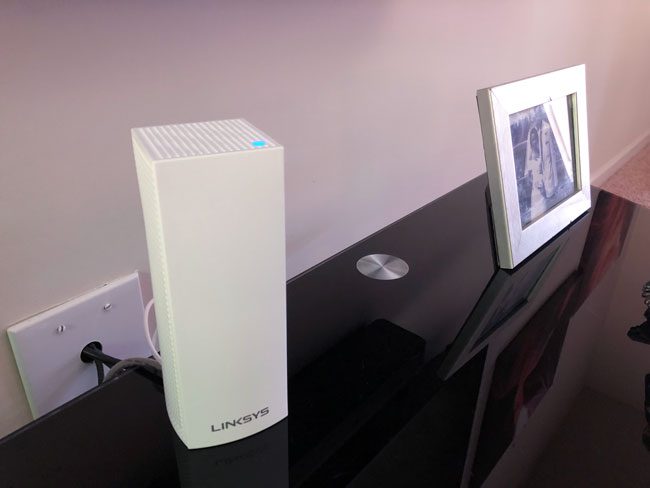
Any product that has that many reviews on Amazon and manages to still have a 4.5 star rating means that people must really like it. I got mine setup and I could easily give it a 4+ star rating, but it’s not perfect…
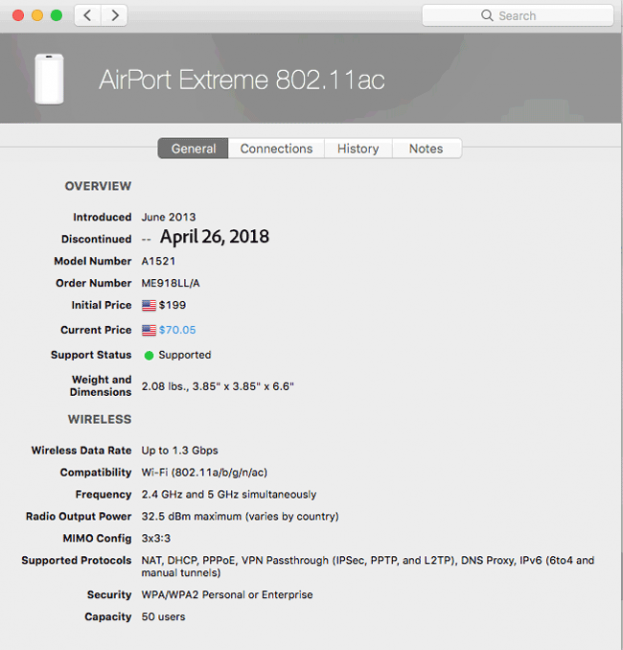
Let’s start with the good and even the great
Linksys Velop is a WiFi mesh system. That means that you buy two or more depending on the size of the home/apartment you’re trying to cover. Each node is rated to cover 2,000 square feet. A two node Velop system should cover most 1-2 bedroom apartments/homes and a three node Velop system
should cover a 5 bedroom/6,000 square foot home. Now of course this all depends on the walls/floors/ceilings in your home. Some homes are built like bunkers and wireless signals have a harder time making it from room to room to room. Other/newer homes are built with materials that make it a bit easier to get good coverage. I bought the 3 node Velop system
to cover a newer 4,100 sq foot home.
With my existing AirPort Extreme network I had 3 base stations. I had two upstairs on each end of the house and the third one on the first floor kind of in the middle of the house. I had ethernet run to a few rooms when I had the house built (should have done more rooms) and this means that I could plug the AirPorts into ethernet to get maximum speeds without having to repeat the signal from one base station to the next. However, I know that MOST homes don’t have ethernet these days. That’s where a “mesh” system comes in. You plug one node (Velop) into your router and then put the other one(s) in other rooms/floors and they communicate with each other wirelessly! Unlike older wireless setups like Airport the speed won’t/shouldn’t decrease by like 50% because you’re repeating the signal. Linksys claims that it would be 100% of the signal from node to node. Again, this will really vary from home to home. Although I have ethernet in each of the rooms that I wanted to replace the Airports with Velop nodes, I wanted to put one node in the kitchen area so that it would be closer to the patio. This means no ethernet and it would have to communicate with the “parent” node wirelessly.
The Setup Process is Really Good
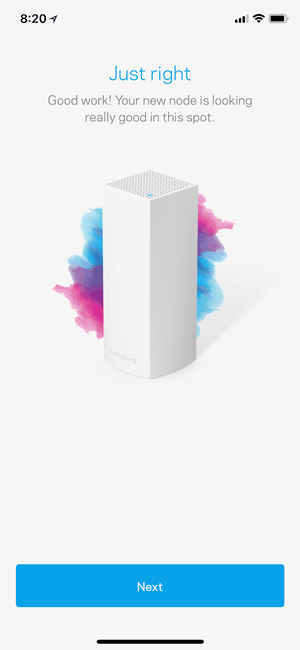
You setup the Velop system from your smartphone or other iOS/Android device. I loved being able to download their App and start the setup process right from my iPhone X. The setup process is really straight forward. You just walk through the steps answering the questions. Linksys Velop can replace your existing router. Although I had AirPort Base Stations (which also act as routers) I had always used a third party router. This was always a weakness of AirPort. When it comes to router configuration and features, AirPort can seem pretty anemic. I had to be able to configure certain features for work back in the day that AirPort never allowed. Therefore I used routers from Trendnet, Netgear and my latest is a TP Link. During my excitement to setup Velop I just configured it to connect to my existing TP Link router. It worked perfectly setting up the 1st (parent) node. Once that one was setup and got the latest firmware update, it then asked if I wanted to setup another one? Before I setup the next one I wanted to change a setting. By default Velop uses a single WiFi network name for both your 2.4GHz and 5GHz channels. I had been using two distinct networks for the faster 5GHz traffic and the slower 2.4GHz traffic. This is where the installation process kinda falls short. Believe it or not, this feature can’t be configured in the mobile app. You have to set this setting via the web interface. I Googled it and found the steps to do it. Now my networks were setup the way that they were on my AirPort base stations with the same network names and passwords. I went back to the mobile app and setup the other two nodes with no problems.
I love the channel optimizer!
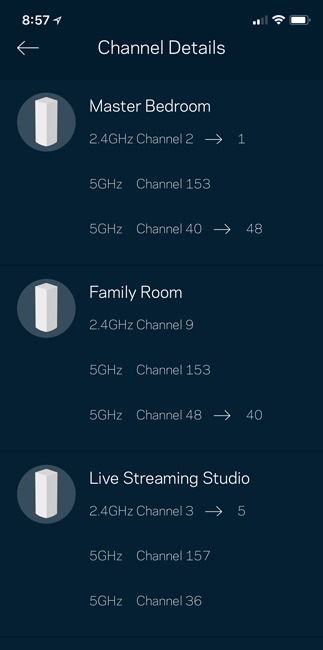
One of the problems with living in an urban neighborhood is that everyone has WiFi. This means that you’ll usually see a bunch of networks and these networks are all using the same channels as yours. 2.4GHz networks are the most crowded because there are fewer channels to choose from. Although 5GHz networks have a lot more channels that doesn’t help if a nearby neighbor happens to be using the same one you’re using. This is where the Velop Channel Optimizer really comes in handy. After you get everything setup you can run it and it compare your existing node channels to what’s around you and make the necessary changes AUTOMATICALLY. That’s almost worth the price of admission alone as it adjust each node based one where it’s actually located and not just the parent/main node.
How well does it work?
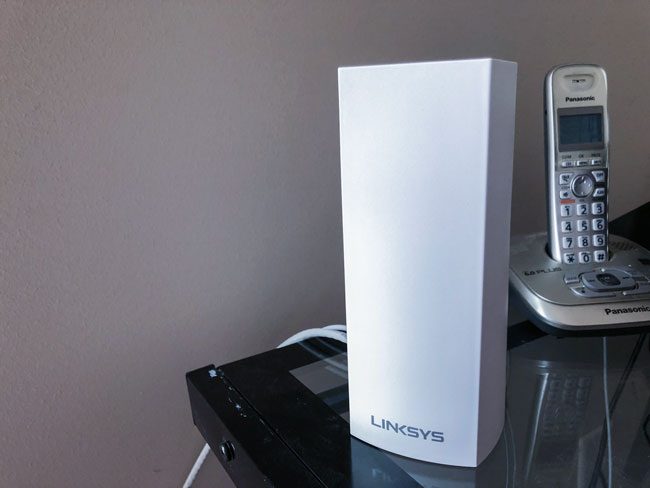
The coverage is definitely as good and probably better than my older AirPort Extreme network. I definitely got better signal with the closer node on the patio and pretty much all of the backyard. The speed also seemed as good as AirPort even on the node that was connected wirelessly.
It even works with Amazon Alexa
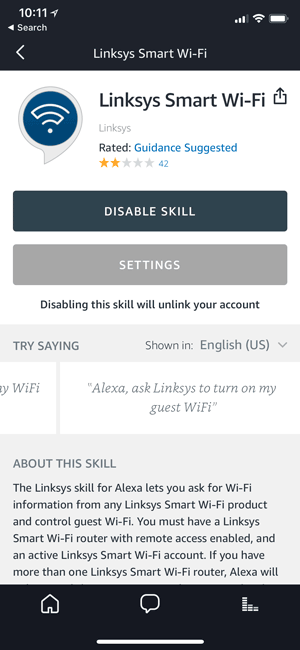
Yep, there’s a Velop skill for Amazon Echo devices. You can do things like “Alexa ask Linksys to turn on my guest network.” “Alexa, ask Linksys what’s my wifi password?”
I also like the fact that you can enable automatic firmware updates that happen at night and only take a few minutes. The problem with most routers is that the firmware updates need to be done manually and most people never check or do them. That means that you’re missing out on potentially important security updates.
Now for the not so good/room for improvement:
I had a great idea and that’s where it went downhill (temporarily)
Like I said above, Linksys Velop is also a router. Instead of running it “bridge mode” to my existing router I woke up the next morning and decided to set it up to actually be my router. This also gives you the complete Velop feature set. In bridge mode you lose some of the features that are router specific. I figured why not let Velop do it all? Routing and WiFi. I went into the settings and switched it from bridge to the default DHCP and connected it directly to my cable modem. This was a bit tricky and I probably should have just scrapped my existing setup and done the setup all over again. However, I got it working.
As a router Velop was SLOWER!!
I can’t explain it (it’s clearly a bug) but apparently I’m not alone. People are complaining that Velop has slowed down their internet speeds. Before I researched it I actually thought it was a problem with Xfinity as both my wireless AND wired speeds were at least half of what they normally are. I called them and rightfully so they asked me to test by connecting a computer directly to my modem bypassing any routers. Yep, the speeds returned. Sigh. I did a Google search and found this thread. No one has a real solution, but I actually fixed it for now. I simply put my TP Link Archer A2300 router back in place and set the Velop backup as a WiFi bridge to it.
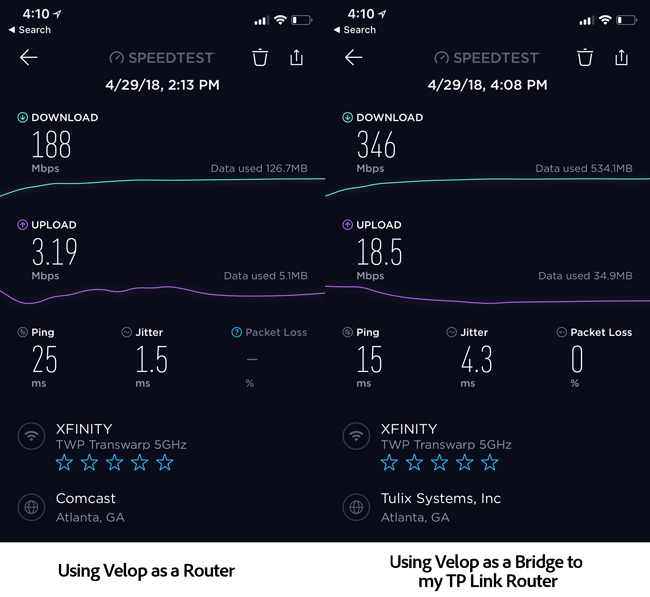
Now I get the speeds I’m supposed to get and it rocks wirelessly too. This is a bit disturbing for a router/mesh that gets such high praise and great reviews. I’ve been in contact with Linksys and they are trying to resolve it. They actually called me three times yesterday to troubleshoot it but unfortunately I couldn’t take their calls while I was working/meetings/live streaming. I have no doubt that this is something that will get fixed, but for now I’m set just using it like I was using my AirPorts. It’s faster and has better coverage than I was getting with AirPort base stations. I’m getting the speeds above on the right even over wifi and more consistently than I was getting them in various areas of my home than I was with AirPort.
The Mobile App is Great Until it’s Not!
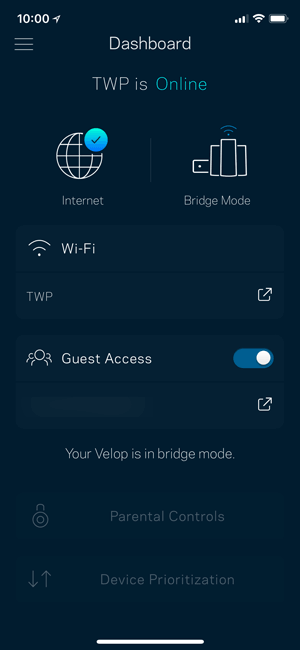
I LOVE being able to control my Velop system right from my iPhone. I was spoiled by the iOS AirPort app too. However, while the Velop app lets you do much more than the AirPort app did, there are a couple of things that you still have to do via the web browser interface. Like I said above, in order to split my network into a 5GHz network and 2.4GHz network I had to use the web UI to do that. OK, no big deal, but the other problem with the App is that it only connects to a Velop for the initial setup process OR if the Velop is online and connected to the internet. That’s not good when you’re trying to troubleshoot or change settings that impact the Velop connecting to the internet. As a last resort you could always factory reset it and gain access to it again to set it up, but that seems like a downer. Now on the flip side if you know your router’s IP address and you can connect to it via ethernet, then you COULD use the web interface to access it even if it wasn’t on the internet. I had to jump through hoops to put the Velop back in Bridge mode because I couldn’t connect to it as it wasn’t on the internet. I finally got it working and like I said in hind sight it might have been faster to just reset it up again.
Velop FAQ
Q. My existing AirPort network is working fine. Do I need to do anything?
A. Nope. Have a nice day. Apple will likely continue security patches for a while/years. However, if you feel like your WiFi network is not fast enough or you have older AirPort Base Stations that don’t support 802.11ac then it might be time to think about upgrading. Otherwise, keep using what you’re using. All is well.
Q. Do I need a “mesh”? Can’t I just buy a WiFi router or use the one provided by my service provider?
A. No, not everyone needs a mesh. It’s very possible that a single WiFi router (yes even the one provided by your ISP) can be enough. Mesh systems are usually for larger homes or homes that tend to have WiFi dead spots. When I lived in Michigan I had a 4,800 sq. foot studio and a single AirPort Extreme Base Station upstairs covered the entire building. Most of the space was wide open. Not a lot of walls.
Q. If I go with the Velop do I have to get 3 nodes?
A. Nope, You can get a two pack or a three pack
. You can also add individual (1 pack) nodes
if needed.
Q. Does the Velop have ethernet ports to attach other wired devices?
A. Each Velop node has two ethernet ports. You will plug the main/parent into your router/modem. The other port is available to attach a ethernet switch or other wired device. You can also plug wired devices into the wireless nodes.
Q. You mentioned that you had rooms with wired ethernet drops. Can you attach Velop nodes via ethernet or do they have to be wireless?
A. Yes, if you have existing ethernet runs throughout your home then you can plug your Velop nodes into ethernet. This will mean less WiFi noise/usage and faster performance. However, keep in mind that this system is designed to be wireless out of the box. Ethernet is NOT required for the other nodes.
Q. What if a node gets disconnected/unplugged or dies, does that kill my WiFi network?
A. Velop is a self healing network. If a node goes offline the other nodes will simply connect to each other instead and keep your network up.
Q. Did you consider any other mesh systems like the Netgear Orbi or Google Wifi?
A. Yes I did, and I’m sure other systems are good too. However, Velop seemed to have the most positive reviews overall.
Q. Can I plug in a USB hard drive and use it like a Time Capsule for Time Machine backups?
A. Sadly no. No USB ports on this system.
The Bottom Line
Overall I’m happy with Linsys Velop. I would (and have) no problem recommending it for those looking for a good WiFi mesh system. Clearly the router issue isn’t affecting everyone or their would be a lot more complaints in the reviews.
You can get the Linksys Velop 3 pack here.

